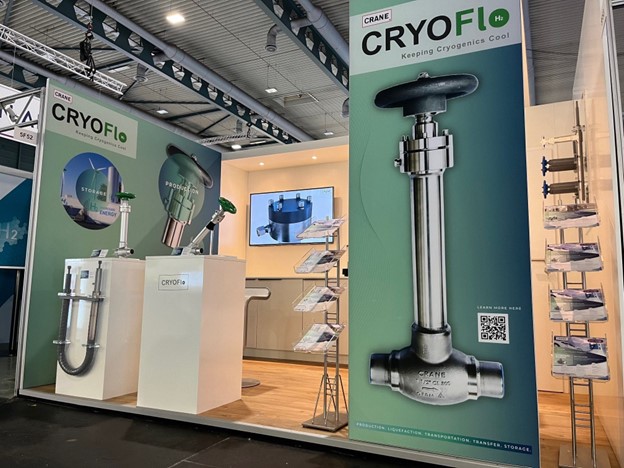The Role of Cryogenics in the New Era of Space Exploration
How CRANE® CRYOGENICS Can Support It
As humanity continues to explore and understand the cosmos, technology, curiosity, and the spirit of discovery are all set to create a pivotal moment in our history. Cryogenics, the study of materials at extremely low temperatures, is a critical field in space technology. The potential of CRANE® CRYOGENICS in the realm of space cryogenics is immense and pivotal for the future of space exploration. In this comprehensive examination, we delve into the multifaceted role of cryogenics in space technology.
Cryogenics in Rocket Propulsion
Cryogenics is at the heart of modern rocket propulsion technology, involving materials at extremely low temperatures, typically below -150°C. Cryogenic fuels like liquid hydrogen and oxygen are critical in space travel, particularly in fueling rockets. In their liquid state at such low temperatures, these fuels offer a high energy density crucial for rockets to achieve the immense thrust necessary to escape Earth’s gravitational pull.
The technological achievements in cryogenic fuels are significant. Liquid hydrogen, for example, has the lowest molecular weight of any known substance and provides the highest energy content per unit of weight, making it an ideal fuel. The Saturn V rocket and its use in the Apollo 11 lunar journey are examples of the importance of cryogenics in rocket propulsion. These historical precedents set the stage for companies like CRANE® CRYOGENICS to innovate and push the boundaries of cryogenic technology in this field.


CRANE® CRYOGENICS is developing expertise in products that support cryogenic fuel production, storage, and transfer. The use of these technologies is essential in the future of space travel. Advancements in cryogenic fuels and propulsion systems are rapidly progressing, with research focusing on enhancing the efficiency and reliability of cryogenic systems. The future of this field includes exploring new fuel combinations and propulsion systems, such as methane-based cryogenic fuels for missions to Mars and beyond.
The success of cryogenics in space exploration heavily depends on the technology of insulation and the choice of materials. Efficient insulation is vital to prevent cryogenic fuels from absorbing external heat, which can cause them to vaporize prematurely. Innovations in insulation technology, like superinsulation, play a key role in reducing heat transfer by radiation.
Developing materials capable of enduring severe thermal stresses at cryogenic temperatures is also crucial. This includes using advanced composite materials in constructing cryogenic fuel tanks and associated systems.
Widening the Scope: Cryogenics Beyond Rocketry
Cryogenics in space exploration extends far beyond rocket propulsion. Its applications range from preserving biological samples in space exploration to enhancing astronomical observations and managing life support systems.
- Safeguarding Life’s Code in Space: Long-duration space missions necessitate preserving valuable biological samples – microorganisms, plant tissues, even human cells – for future analysis. Here, cryogenics steps in as a champion. By plunging these samples into temperatures approaching absolute zero (-273.15°C), their metabolic processes effectively halt, suspending them in a state of near-animation. This allows them to remain viable for extended periods, even years, defying the harsh environment of space.
- NASA’s GeneLab: This orbiting laboratory utilizes cryogenic technology to store plant seeds and microbial cultures, enabling researchers to investigate their adaptability and response to spaceflight conditions.
- Biopreservation for Future Missions: Freezing human cells or sperm could pave the way for future crewed missions to Mars, ensuring genetic diversity and potential reproduction on the red planet.
- Future Focus: Refining cryogenic protocols to minimize cell damage during freezing and thawing cycles and developing miniaturized and energy-efficient cryogenic storage systems for deep space travel.
Cryogenics Unveils the Universe’s Secrets
The universe reveals its hidden secrets through various wavelengths of light, many invisible to the naked eye. Infrared and submillimeter wavelengths, for instance, pierce through dust and gas, offering glimpses into stellar nurseries, distant galaxies, and the echoes of the Big Bang. However, detecting these faint signals demands highly sensitive instruments operating at frigid temperatures. This is where cryogenics comes to the rescue.
- James Webb Space Telescope (JWST): This engineering marvel deploys advanced cryogenic systems to maintain its instruments at temperatures as low as -263°C, enabling unprecedented observations of the early universe and exoplanets.
- Ground-based Observatories: Powerful telescopes like ALMA in Chile utilize cryogenic technology to detect faint cosmic radio emissions, shedding light on star formation and black hole activity.
- Future Focus: Pushing the boundaries of cryogenic cooling to achieve even lower temperatures for next-generation telescopes, expanding our cosmic vision and developing compact and cost-effective cryogenic systems for more minor, space-based observatories.
Cryogenics Keeps Astronauts Alive
Beyond its celestial applications, cryogenics plays a crucial role in ensuring the well-being of astronauts venturing into the unforgiving void. Life support systems onboard spacecraft rely on this technology for several critical functions.
- Air Revitalization: Removing carbon dioxide from the cabin atmosphere, a potentially toxic byproduct of human respiration, is essential for crew survival. Cryogenic techniques like the Sabatier reaction efficiently convert CO2 into breathable oxygen and water.
- Temperature and Humidity Control: Maintaining comfortable temperatures and humidity levels within the spacecraft is crucial for astronaut health and well-being. Cryogenic systems can play a role in heating and cooling, ensuring a habitable environment.
- International Space Station (ISS): The ISS utilizes a complex life support system, partially based on cryogenic technology, to sustain its crew for extended periods.
- Future Deep Space Missions: As we venture further into the solar system, reliable and efficient cryogenic systems for air and temperature control will be critical for long-duration missions.
- Future Focus: Developing robust, energy-efficient cryogenic life-support systems for deep space habitats and vehicles and integrating cryogenic technologies with alternative life support systems like bioregenerative life support.
Unveiling the Universe’s First Light
The Cosmic Microwave Background (CMB) radiation, a faint afterglow from the Big Bang, holds invaluable clues about the universe’s origins and properties. Studying this faint signal requires susceptible detectors operating at near absolute zero temperatures, achieved through advanced cryogenic technology.
- Planck Space Telescope: This ESA mission employed a sophisticated cryogenic system to map the CMB with unprecedented detail, providing crucial insights into the universe’s age, composition, and expansion.
- Ground-based CMB experiments: Telescopes like the Atacama Cosmology Telescope (ACT) utilize sophisticated cryogenic systems to study the CMB and refine our understanding of the early universe.
- Future Focus: Developing next-generation CMB detectors with even higher sensitivity and angular resolution, pushing the boundaries of our
cosmological understanding. Exploring alternative cryogenic technologies for CMB experiments, such as solid-state cooling systems for greater portability and efficiency. The future of this field includes developing more sensitive detectors and cooling systems, which can be a significant area for innovation and growth.
Conclusion
Cryogenics is a pivotal field in space technology; a lot is at stake, and excitement is present. To carry these cryogenics, sustainable and viable products are required. Cryogenics is significant in space exploration, from rocket propulsion to life support systems and astronomical observations. CRANE® CRYOGENICS will establish itself as a critical player in this cryogenics production, storage, and transfer technology.
As humanity continues to explore and understand the cosmos, cryogenics will undoubtedly play an even more critical role in our future endeavors. CRANE® CRYOGENICS’s continued contributions to this field will be essential in propelling us forward in our quest to explore the unknown depths of space.
Discover More Here
CRANE® CRYOGENICS offers Pipe Valves and Fittings (PVF) solutions for the production, transportation, transfer, and storage of Hydrogen, backed by decades of field experience in severe service applications.
CRANE CRANE® CRYOGENICS – CRANE ChemPharma & Energy (cranecpe.com)




